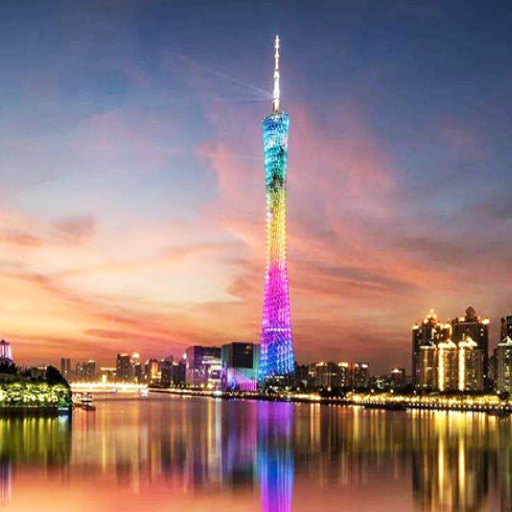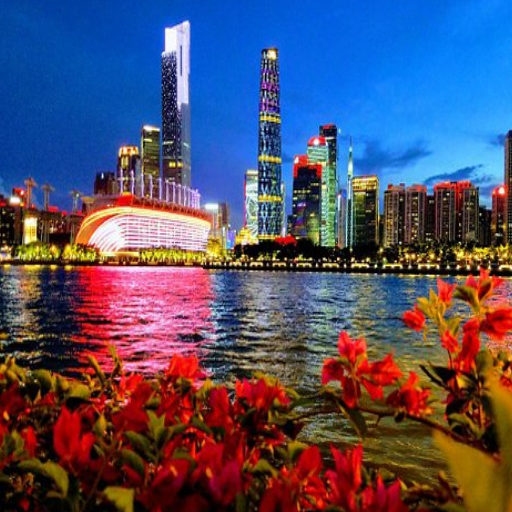No doubt you’re familiar with the fact that Guangzhou is renowned as the “City of Flowers.” It is located in So China and is popular for its vibrant, rich culture. People flock to the city from all corners of the planet just to get a taste of its splendid food, iconic structures, and scope of majestic cultural heritage. Whether you want to immerse yourself in traditional temples, witness marvelous skyscrapers, or gastronomical feasts, from Cantonese delicacies to numerous other world-class cuisines, this city will ensure you never run out of options to pick from, no matter your preference. This is why this city is one of the most sought-after travel destinations. This guide focuses on tips for the tourist and the city’s main attractions to make the most out of their stay.
What are the Top Attractions in Guangzhou?

Exploring the Iconic Canton Tower
The refinement in the design of the Canton Tower is innovative and strong at the same time, presenting a symbol of ebullience and a new-fangled culture for the Cantonese people. With a towering height of 600 meters, it stands as the thirty place toward China’s tallest freestanding structures and tutorial of guns. The tower offers a breathtaking Guangzhou view from observation deck 488, the highest observation deck on one door worldwide. The Canton Tower is also one of Guangzhou’s land machs and an emblem of Tai’s contemporary habitations.
On the other hand, you can go to different activities while watching the whole city, to amazing unimaginable views of the world’s largest horizontal Ferris wheel and astonishing jump thrill. In addition, its fast elevators prove to be cutting-edge technology, as they enable the building to offer guests a ride on their fastest elevators, headed to the top of the tower in under a minute. In conclusion, if you love the feeling of adrenaline pumping in you or are a simple person who loves towering views, grabbing a trip to the tower is a no-brainer.
Highlights of the Chen Clan Ancestral Hall
The Chen Clan Ancestral Hall, known more popularly as the Chen Clan Academy, typifies modern traditional Cantonese architecture and sculpture. Constructed in 1894 during the late Qing Dynasty, the Hall was primarily used by the Chen family for worship and studying for the imperial examinations.
This incredible structure also features intricately painted murals and delicate ironwork. These, along with the beautifully crafted wood carvings, stone sculptures, and ceramic ridge pieces, emphasize the unrivaled mastery of artisanship that utilized an area of over 13,000 square meters. The compound contains nine primary halls and six secondary courtyards bound together by a symmetrical network of pathways.
In addition to being an acclaimed historical architectural structure, the Chen Clan Ancestral Hall is also a folk art museum in the southern region of China. It is a beautiful heritage site that further expands understanding of the art and culture of Guangdong province.
A Journey through the Guangzhou Opera House
One of Guangzhou’s most recognized cultural symbols is the Guangzhou Opera House, which portrays a philosophical view of contemporary architecture. The opera house covers 70,000 square meters and includes a main auditorium for 1,800 spectators and a smaller multi-use chamber with 400 seats. It was designed by the world-renowned architect Zaha Hadid, who envisioned the structure as a sculptural space for artworks that integrate flowing forms and high-level structural outlines.
58 Abstract concepts of Informed and Non-Linear design led to the building’s form that captures two rounded forms of smooth rocks arched over and resting adjacent to the Pearl River. The region is the southern part of Guangzhou city. The futuristic look of the buildings is achieved not only by the diamond-shaped aluminum panels and glass but also by reinforced concrete and steel. The sophisticated system of the combined sound-reflecting panels and modern sound devices provided a coherent perception of the bass sound with the rest of the parts. The architectural and functional design offers its full integration from any perspective, observing the structure and showing the Guadalajara Opera House as a modern multifunctional performance object.
How to Explore Guangzhou Efficiently?

Planning Your Guangzhou Trip
Exploring every aspect of the city requires careful planning to maximize your stay in Guangzhou. Prioritizing aspects that need attention first is of great importance. For culture and architecture devotees, landmarks such as the Guangzhou Opera House, the Canton Tower, and The Chen Clan Ancestral Hall are phenomenal. Everyone knows that Shamian Island is one of the most beautiful historical places reflecting the city’s colonial era. You can also indulge in shopping and savoring the food on the crowded Beijing Road. It is always recommended to cluster attractions close to each other to minimize time spent traveling.
Gouging time in a city involves effective planning, particularly about transportation. For a big city like Guangzhou, good metro and public transport with busses and taxis are expected. The Guangzhou metro area is particularly convenient for tourists, as all significant landmarks and districts are connected. A metro trip will cost you between 2 and 14 RMB, depending on how far you plan to travel. Purchasing a prepaid Yang Cheng Tong card is recommended for smooth traveling around the city. Commuting during busy hours should be expected since the metro does tend to get crowded. If you want to go to outer districts or simply have more flexible plans, the Didi app is also good since it provides options for hailing taxis.
Check when it is most suitable for you to travel to Guangzhou. The city’s climate zone is classified as subtropical and features warm winters and hot, moist summers. Spring (March to May) and autumn (September to November) are the preferable periods to travel because of the enjoyable outdoor activities that can be conducted during this time. Use caution when packing for the summer months by including lightweight clothing. For the cooler months, include a light jacket in your luggage. Enrich your visit with local attractions like the Canton Fair, which is geared towards people from all walks of life. If the proper steps are taken, an enjoyable and effortless stay in Guangzhou is achievable.
Uncovering Old Guangzhou
Walking through Old Guangzhou lets me experience the city in a new light, with its culture and history standing tall. The streets of Xiguan are filled with traditional Lingnan-style houses with finely crafted wooden carvings and spacious verandas. Walking through the narrow alleys, I am captivated by the charm of the preserved old workspaces and tea houses, which offer me an idea of how life once flourished in this city. My emotional connection with the city’s past makes me appreciate its roots and evolution into a modern metropole.
The Chen Clan Ancestral Hall is one of the most remarkable places I visited. It is like no other building I have ever seen because of the beautiful Chinese architecture added with finely sculpted ceramic pieces. The hall is a culture center and displays the masters’ and craftsmen’s skills from Guangzhou. It is also essential to observe the carving with lots of details inflicted in it, the central part of the building and the proportions, due to the deep-rooted ideas of symmetry and equilibrium, which are highly regarded in Chinese culture. Most of these features have been well preserved and displayed beautifully. Therefore, it is not a surprise many people travel to this place in search of the magnificent image of an artistic wonder of the region.
Moreover, I visited Shamian Island, an exceptional region narrating colonial Guangzhou’s history. While there, I appreciated the combination of European-style structures with green space, contrasting with the city’s rest. This area demonstrates Guangzhou’s international trading relations and still retains appeal. Visiting these cultural places helped me appreciate the juxtaposition of the former and contemporary. Preservation efforts guarantee the sites’ authenticity, while modern tourism makes protecting the area’s history possible for future generations.
Must-Visit Guangzhou Attractions
Perhaps the most intriguing place I visited in Guangzhou was the former Chen Clan Ancestral Hall. The building is a late Qing Dynasty sculptural masterpiece with deft wood, stone carvings, and vivid ceramic embellishments. The hall’s function as a venue for family celebrations and educational devotion reveals its broader scope of culture, shedding light on traditional Chinese customs and values.
Canton Tower, emblematic of modern Guangzhou, was also among the highlights. Standing at 600 meters, it is the tallest structure in Guangzhou. Seeing the monstrous engineering marvel that the building brought forth was fascinating. Its observation decks allow for a breathtaking scale range view of the panoramic scenery of the city. In addition, the tower’s twisting form and its resistance to extreme wind are another remarkable detail. It is not only a must-visit point for tourists but integrates the innovation of skyscraper engineering, which makes it worth pondering for architectural experts.
Finally, my visit to Shamian Island was remarkable. The island’s untouched greenery and the colonial architecture from the bygone era reflect the everlasting impact of international trade on Guangzhou. The island’s carefully preserved infrastructure and heritage buildings showcase the successful preservation efforts undertaken. Preservation methods like adaptive reuse and structural reinforcement guarantee that Shamian Island will continue to be admired and explored by future generations.
What are the Best Guangzhou Tours?

Experience a Pearl River Night Cruise
No better way exists to admire Guangzhou than believing in a Pearl River Night Cruise. For starters, the cruise gives breathtaking views of Guangzhou, with Canton Tower and the bridges shimmering with light, some of its significant junctures. The cruise offers a scenic and tranquil way of experiencing the charm of Guangzhou at night, which lasts around 70-90 minutes.
Cruise Duration: At 90 minutes, it perfectly fits within time restrictions, enabling passengers to cruise leisurely and thoroughly appreciate the place’s scenic beauty.
Departure Points: Cruises usually start at Tianzi Pier or Dashatou Wharf, easily accessible from different locations.
Best Timing: Between 7 p.m. and 10 p.m., the best views of the city lights are offered as the sun sets.
Seating and Capacity: Open-air seating on the deck enables charming, unobstructed views.
Comfort and Facilities: Ensure refreshments and outer seating that enhance the overall comfort of the ride.
These identified aspects guarantee an unforgettable and pleasant sightseeing venture from the water around Guangzhou.
Adventure through Chimelong Safari
My visit to ‘Chimelong Safari’ was probably one of my most exhilarating experiences. The combination of a safari with an amusement park is perfectly balanced with the attractions and the animals. The open spaces where the animals were kept added to the awe. In terms of specifics:
Capacity and Seating: The vehicles used for the Safari were quite spacious, with enough space for each passenger to comfortably take pictures from their seats.
Comfort and Amenities: The vehicles were comfy with well-padded seats and shaded windows for sunny days, making the drive pleasurable and relaxing.
In combination with the park’s overall environment, Chimelong Safari was a world-class experience. Looking at some technical details, the vehicle seemed best suited for medium-sized teams, as most comfortable seating arrangements accommodate 8-12 people. The tracks were also designed to provide the viewer with many opportunities while prioritizing the animals’ well-being.
Why is Guangzhou a Top Destination in Southern China?

Understanding the History and Culture of Guangzhou
Guangzhou’s vibrantly rich culture and history make it an exquisite place to visit in southern China. Guangzhou, for instance, began as a port city on the ancient Maritime Silk Road, which acted as the main trade route for other cities and later evolved into a modern port city. This development as a trade and culture hub was further enhanced through the blended heritage of the town, from Cantonese cuisine and tea culture to Lingnan architectural styles and modern skyscrapers. The cuisine and the blend of modern buildings and Lingnan architecture remind me of how stunning Chen Clan Ancestral Hall and Qingping Market are, deepening my appreciation for the city even more.
A few technical parameters stand out. The city’s transportation system dramatically complements historic and cultural sites, making them easy to visit. Not only is the subway well mapped, but there is also an abundance of signage in different languages. Furthermore, the attractions have audio guides, interactive exhibits, and guided tours that aid in the tourist’s learning experience. These features make Guangzhou’s cultural heritage more enjoyable, accessible, and understood.
Exploring the Mausoleum of the Nanyue King
This mausoleum was an enormous resting place for the King of Nanyue, which was built in 122 BC. This mausoleum is located in Guangzhou, and it is essential because it contains the cultural identity of the Nanyue Kingdom. Within the mausoleum are more than 1,000 exquisite relics of gold bronze vessels, jade pieces, and ceramic pottery, all of which depict the technological and artistic advancement of that period. Within the premier chamber, the exquisite jade sarcophagus, uniquely fashioned from thousands of individual jade plaques owned by Zhao Mo, the 2nd king of the Nanyue kingdom, lies there.
One of the site’s notable features is the multi-chamber tomb sculpted into a slope. It provides a climate-controlled, eternal resting place and is the most suitable location for preserving artifacts. Guided tours, with signage in different languages, information in the form of visuals, and the importance of the site make it easy for anyone of any origin to comprehend.
Visiting the Sacred Heart Cathedral
The Sacred Heart Cathedral, or the Stone House, is one of Guangzhou’s best examples of Gothic Revival architecture. This majestic structure was erected in the 19th century and is known for its entirely stone facade, which consists of walls, columns, and even rib vaults.
Structural Design: It has dual spires, each reaching about 58 meters, complementing the Cathedral’s grandeur and significance in the city.
Material Usage: The entire structure is made of high-quality granite, which ensures durability and stability and makes it look exceptional due to the great stonemasonry.
Climactic Adaptations: The stone and well-designed vent systems protect the interior from Guangzhou’s humid climate, improving the building’s life expectancy.
Lighting and Acoustics: Stain glass windows have been integrated into the structure to enhance the electrically charged atmosphere while optimizing natural light. The structure’s acoustics also enhance choral singing during Mass.
Guided tours are offered at the site, and due to the multilingual explanations and easy pathways, people of all backgrounds can appreciate the cathedral’s cultural and religious importance.
What Featured Places Should You Not Miss in Guangzhou?

Wandering through Shamian Island
As a remnant of colonial history, Shamian Island bears a beautiful mixture of European structures and serene green vegetation. It was Shangai Island during its peak of foreign trade in the 19th century. The island, now home to preserved colonial buildings erected in gardens, features cobblestone roads, charming gardens, and Thai and French Towns. Travelers can admire essential structures, including the French Catholic Church and the English Anglican Church, located on the tree-lined avenues.
Location: Shamian Island, Liwan District, Guangzhou
Architecture: A mix of classical revival and neo-gothic styles, predominately 19th-century European.
Walkability: Rest areas and pathways with shade make it very pedestrian-friendly.
Cultural Highlights: Historic relics such as the bronze statues of Huang Xing and the museums along Qing Avenue bear remarkable representations from the Chinese and European worlds.
Accessibility: It provides many pedestrian routes and is reachable through the metro, Huangsha Station, with Line 1.
Visitors seeking quieter places to balance the city’s hustle and bustle will find this gem particularly useful. It is a must-visit for those fascinated by history.
Taking in the Views at Baiyun Mountain
Mountain Baiyun, also known as Baiyun Mountain, is situated in the Baiyun district in Guangzhou; it is the perfect getaway, no matter the needs of nature lovers and outdoor enthusiasts. The peaceful environment and the views from Baiyun are breathtaking. People who seek a retreat from the city’s hustle will find it peaceful while adding to their enjoyment. I loved the stunning panoramic views at Moxing Summit, where I could see the tallest Great Peak in the Mountain Baiyun Region make its way to the city. On top of that, the location served as the highest in the region and offered mind-blowing views of the city.
Height: Viewers get a 360-degree view of the peak and breathtaking memories of the Moxing Summit’s top point, 382 meters (1253 feet) above sea level.
How to reach: There are walking paths and a car service for visitors who wish to make their journey easier.
Other features: Visitors can enjoy tea services on the viewing and resting platforms and in the park.
Environment: A positive sense of peace is further added by the boiling vegetation and variety of plants and the chance of coming across the flora and fauna of the country.
Timings: It can be visited after sunrise and until sunset so guests can experience the sun at dawn or dusk.
With the breathtaking views of Guangzhou’s natural locations, this location is ideal, and I highly recommend it for exercise and rest after a busy week.
Exploring the Sun Yat-sen Memorial Hall
The most stunning part of my trip was the architectural masterpiece of the Sun Yat-sen Memorial Hall, which served as a focal point for history and architecture. This marvelous structure, located in the center of Guangzhou, is dedicated to a prominent character in modern China’s history: Sun Yat-Sen. The fantastic combination of traditional Chinese designs with modern features not only gives the hall great beauty but also great significance.
Capacity: The interior auditorium can host an astonishing 3,238 people for ceremonial or cultural functions.
Accessibility: It can also be reached by various modes of public transport. Metro stations and bus stops are nearby, and ramps are provided for wheelchair users.
Structure: The significance of the octagonal shape is symbolic, meaning stability and balance in Chinese culture.
Visiting Hours: The Memorial Hall usually operates from 8 a.m. to 6 p.m., which is a generous time for visitors to explore. The entry fee is low, and tickets can be easily reserved online.
This landmark is a must-see for those interested in the history and modernization of China in the 20th century. Its calm environment allows visitors to contemplate Sun Yat-sen’s marvelous legacy.
Frequently Asked Questions (FAQs)
Q: Which activities are best suited for Guangzhou?
A: Guangzhou is packed with famous attractions and favorite sightseeing spots. Some of the best things to do are climb the Canton Tower, visit Chen Clan Academy, walk-in Yuexiu Park, the Temple of the Six Banyan Trees, and learn about the culture of Canton. Local experiences and activities can be enjoyed at the Guangdong Museum while cruising the Pearl River or shopping at the city’s bustling local markets.
Q: What is unique to the Guangdong Folk Art Museum?
A: The Chen Clan Academy, also known as the Guangdong Folk Art Museum, is an intricate collection of 19 buildings that exemplify traditional Cantonese architecture and folk art. It contains wood carvings, pottery, and other art pieces that depict the Guangdong province’s cultural history. This is one of the finest places to gain insight into regional historical events and artistic endeavors.
Q: What is the significance of Yuexiu Park in Guangzhou?
A: As Guangzhou’s biggest park, Yuexiu Park is regarded as one of the top sightseeing locations in the city. The park encompasses the famous Five Rams Sculpture, a town hallmark, and Zhenhai Tower, which contains the Guangzhou Museum. The combination of natural splendor and crucial historical value makes the park a treasured place for tourists and residents.
Q: Is there an essential Catholic cathedral in Guangzhou?
A: Yes, Sacred Heart Cathedral, known locally as the Stone House, is an important Roman Catholic cathedral in the city. Constructed in the 19th century, it is China and Southeast Asia’s most significant Gothic structure. Its marvelous design adds to the rich array of landmarks in the city’s center.
Q: What can visitors expect to see at the Guangdong Museum?
A: It is a modern cultural institution that displays the history and culture of Guangdong province. Visitors can appreciate its natural history, art, and ethnology collections. In addition, the museum contains Nanyue kingdom relics, such as the Tomb of Zhao Mo, which offers a glimpse into the region’s history.
Q: Are there any scenic spots near Guangzhou for those who love nature?
A: Yes, Baiyun Mountain is a must-visit site for nature lovers. It is located north of Guangzhou and offers stunning hiking paths, cable cars, and incredible city views. Nansha Wetland Park, situated near the Pearl River Delta, is another alternative. It is a quieter place where people can escape to nature and go bird watching.
Q: What is a popular attraction for tourists in Guangzhou for evening leisure activities?
A: People like to cruise the Pearl River in the evening. The view from the boat is jaw-dropping. The modern-day skyline is lit up, and the famous Canton Tower and other tall buildings can be seen. Many eateries and pubs serve delicious Cantonese dishes and welcome people to experience the city’s nightlife.
Q: Will there be any modifications or new additions to Guangzhou’s sights by 2025?
A: Improvements to preexisting and new attractions are planned for 2025 in Guangzhou as the city continues to change in scope. This specific city is looking to develop its culture and green infrastructure. Although particular plans could change, tourists can see the continual development of the Guangzhou International Finance Center, enhancements to the transportation infrastructure, and perhaps new museums or exhibit halls that capture the city’s history and contemporaneous development.